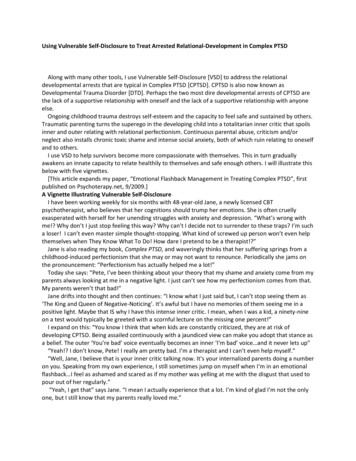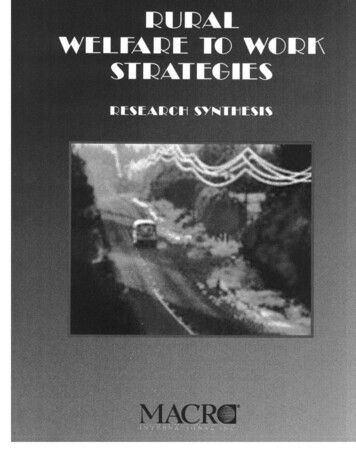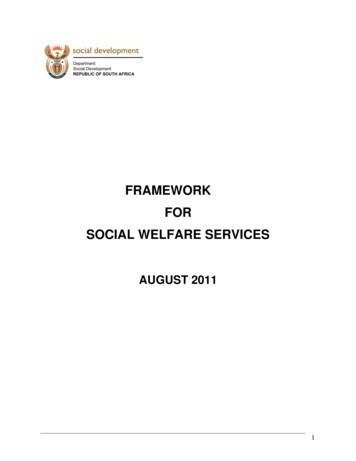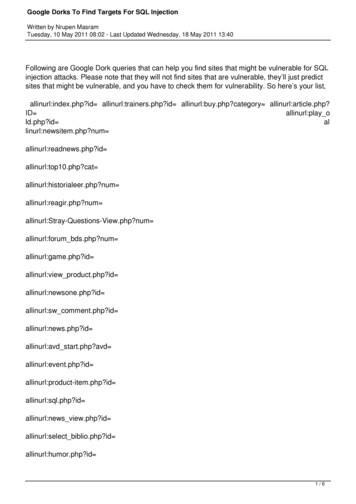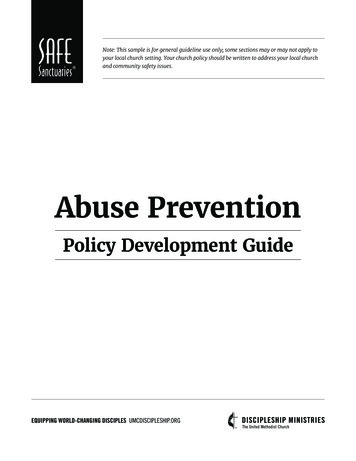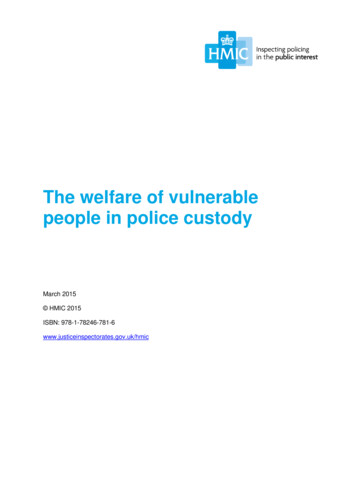
Transcription
The welfare of vulnerablepeople in police custodyMarch 2015 HMIC 2015ISBN: mic
ContentsGlossary . 5Executive summary. 16Introduction . 16Inspection commission . 16Approach . 16Findings . 17The nature of vulnerability . 17First point of contact and diversion. 18In the custody suite33 . 19Release or transfer from police custody . 20BAME detainees . 21Leadership, governance and accountability . 21Partnership working . 22Conclusion . 23Chapter 1 - Introduction. 25Inspection aims . 28Approach . 28Inspection questions . 31Structure of this report . 32Chapter 2 - The legislative policy and framework . 34Police powers of detention . 35Rights in custody . 36Length of detention . 37Additional guidance . 39Policy context . 39Chapter 3 - Analysis of nationally published data. 42What the data tell us . 44
Custody data . 44Use of police custody as a place of safety under the Mental Health Act 1983. 47Data limitations . 47Chapter 4 - The nature of vulnerability . 50Summary of research and inspection report findings . 50Vulnerability in police custody . 52Chapter 5 - First point of contact and arrest . 54Information sharing – police, local authorities and the NHS . 57The decision to arrest and take into police custody . 58Chapter 6 - In the custody suite . 67Who is taken into police custody?. 68Reasons for detention. 72Repeat detentions. 73Use of custody as a place of safety under section 136 of the Mental Health Act1983. 73Arrival in custody . 76Length of time in custody . 82Risk assessment. 83Searching and strip-searching . 87Access to appropriate adult services . 91Local authority accommodation for children in police custody . 92Use of force in custody . 94Healthcare . 97Chapter 7 - Release or transfer from police custody . 104Chapter 8 - Leadership, governance and accountability . 108Focus on vulnerability and custody . 109Understanding risks and demands on the service . 1103
Chapter 9 - Summary findings . 114Practice. 114Management . 118Chapter 10 - Conclusions and recommendations . 121Conclusions . 121Recommendations . 123Annex A. 130Annex B. 135Annex C. 137Annex D. 151Annex E . 166Annex F . 1704
GlossaryAAappropriate adultACPOAssociation of Chief Police Officersanti-social behaviourbehaviour by a person which causes or is likely tocause harassment, alarm or distress to one ormore other persons not of the same household asthe person (see section 101 of the Police Reformand Social Responsibility Act 2011)APPauthorised professional practiceappropriate adultindividual whose role is to safeguard the welfareand rights of children and vulnerable adultsdetained or interviewed by police; he may be aparent or other relative, or a designatedprofessional such as a social worker; all childrenand any adult who is identified as mentally ill ormentally vulnerable should have a designatedappropriate adultAssociation for thePrevention of Tortureinternational non-governmental organisationfocused on the prevention of torture and otheracts of cruel, inhuman or degrading treatmentAssociation of ChiefPolice Officersprofessional association of police officers ofassistant chief constable rank and above, andtheir police staff equivalents, in England, Walesand Northern Ireland; leads and coordinatesoperational policing nationally; a company limitedby guarantee and a statutory consultee; itspresident is a full-time post under the PoliceReform Act 2002authorised professionalpracticeofficial source of professional practice on policing,developed and approved by the College ofPolicing, to which police officers and staff areexpected to have regard in the discharge of theirdutiesBAMEBlack Asian and Minority Ethniccall-handlerworker (usually a member of police staff and not apolice officer) who answers telephone calls from5
the public, determines the circumstances of thecall, and decides what the initial response will beCare Quality Commissionindependent regulator of all health and social careservices in Englandcautionformal warning that is given to a person who hascommitted a minor crime and admitted theoffence; if the person refuses the caution then hewill normally be prosecuted through the normalchannels for the offence; although it is nottechnically classed as a conviction (as only thecourts can convict someone) it can be taken intoconsideration by the courts if the person isconvicted of a further offencechief officerin police forces outside London: assistant chiefconstable, deputy chief constable and chiefconstable; in the Metropolitan Police Service:commander, deputy assistant commissioner,assistant commissioner, deputy commissioner andcommissioner; in the City of London Police:commander, assistant commissioner andcommissioner; also includes a member of policestaff who holds equivalent status to a police officerof these rankschildperson under the age of 18College of Policingprofessional body for policing in England andWales, established to set standards ofprofessional practice, accredit training providers,promote good practice based on evidence,provide support to police forces and others inconnection with the protection of the public andthe prevention of crime, and promote ethics,values and standards of integrity in policing; itspowers to set standards have been conferred bythe Police Act 1996 as amended by the Anti-socialBehaviour, Crime and Policing Act 2014community resolutionway of resolving less serious offences and/or antisocial behaviour incidents through informalagreement between the parties involved, as6
opposed to progression through the criminaljustice systemConvention on the Rightsof Persons withDisabilities 2006international human rights treaty of the UnitedNations, intended to protect the rights and dignityof persons with disabilitiesCQCCare Quality CommissionData Protection Act 1998legislation that controls how personal informationis used by organisations, businesses or thegovernmentdiversion schemesschemes provided by the police and otheragencies aimed at diverting children andvulnerable adults away from custody by providingadvice and supportdiversitypolitical and social policy of promoting fairtreatment of people of different backgrounds orpersonal characteristics; the Equality Act 2010specifies nine protected characteristics in thisregard: age, disability, gender reassignment,marriage or civil partnership, pregnancy andmaternity, race, religion or belief, sex, and sexualorientationfront linethose members of police forces who are ineveryday contact with the public and who directlyintervene to keep people safe and enforce the lawhe/him/his/she/herthe use of the masculine gender includes thefeminine, and vice versa, unless the contextotherwise requiresHealth and Social CareInformation Centrenational provider of information, data and ITsystems for commissioners, analysts andclinicians in health and social careHSCICHealth and Social Care Information CentreIPCCorganisation established under the Police ReformAct 2002, responsible for overseeing the policecomplaints system in England and Wales,including monitoring the way complaints arehandled by local police forces; it investigates themost serious complaints, incidents and allegations7
of misconduct; can call in the most serious casesfrom forces; can manage or supervise a policeinvestigation into a complaint; and can deal withappeals from people who are not satisfied with theway their complaint has been dealt with by thepoliceintimate searchessearches by police under the Police and CriminalEvidence Act 1984 (PACE) of a person’s bodycavities when suspected of hiding drugs oroffensive weapons upon their person; they mayonly be carried out if there are reasonablegrounds for believing that a person who has beenarrested and is detained may have concealedanything which could be used to cause physicalinjury; also, in the case of suspected couriers ordealers only, a Class A drug; searches for harmfularticles are conducted by suitably qualified people:in the case of searches for drugs, a registereddoctor or nurse can carry out the search; if this isnot practicable, a constable will carry out thesearchIPCCIndependent Police Complaints Commissionliaison and diversionteamsschemes provided by the police and otheragencies, particularly the health service, aimed atdiverting people with mental health problemsaway from custody by providing advice andsupportLSCBLocal Safeguarding Children’s BoardLocal SafeguardingChildren’s Boardlocal forum at which organisations (including localauthorities, the police, the probation service andheath services) come together to agree on howthey will cooperate with one another to safeguardand promote the welfare of children; establishedby the Children Act 2004, which gives a statutoryresponsibility to each locality to have one in placeMental Health Crisis CareConcordat 2014agreement signed in February 2014 by 22 nationalbodies involved in health, policy, social care,housing, local government and the third sector;sets out how these organisations will worktogether better to make sure that people receive8
the help they need when they are having a mentalhealth crisisNational PreventiveMechanism18 designated organisations that carry out visits toplaces of detention, to monitor the treatment ofand conditions for detainees and to makerecommendations regarding the prevention of illtreatment; requirement of the Optional Protocol tothe United Nations Convention against Tortureand other Cruel, inhuman or Degrading Treatmentor Punishmentneighbourhood policeofficersteam of police officers and police communitysupport officers who predominantly patrol and areassigned to police a particular local community;teams often comprise specialist officers and staffwith expertise in crime prevention, communitysafety, licensing, restorative justice and schoolsnon-notifiable offencesless serious offences that do not have to benotified to the Home Office (such as breach of thepeace or anti-social behaviour) and may be dealtwith, for example, by police issuing a penaltynotice for disordernotifiable offencesincludes all offences that could possibly be triedby jury and have to be notified to the Home Office(including some less serious offences, such asminor theft that would not usually be dealt with thisway); definition set out in the Home Office’s UserGuide to Home Office Statistics, 2011NPMNational Preventive MechanismOPCATOptional Protocol to the United NationsConvention against Torture and other Cruel,Inhuman or Degrading Treatment or PunishmentOptional Protocol to theUnited NationsConvention againstTorture and other Cruel,Inhuman or DegradingTreatment or Punishmentreaffirms that torture and other cruel, inhuman ordegrading treatment or punishment are prohibitedand constitute serious violations of human rights9
out-of-court disposalone of several methods of concluding the action ofthe criminal justice system in respect of a crimewithout proceeding to a prosecution; they areadministered and effected by the police, andenable them to deal quickly and proportionatelywith low-level, often first-time offences; examplesinclude cautions, cannabis warnings, penaltynotices for disorder, and community resolutions;some have a statutory basis, and some do notPACEPolice and Criminal Evidence Act 1984PACE Code Gadvises officers on the use of discretion: ‘the useof the power [of arrest] must be fully justified andofficers exercising the power should consider ifthe necessary objectives can be met by other,less intrusive means’ (para 1.3)partner agenciespublic sector entities, such as those concernedwith health, education, social services and themanagement of offenders, which from time to timework with the police to attain their common orcomplementary objectivespartnershipco-operative arrangement between two or moreorganisations, from any sector, who shareresponsibility and undertake to use theirrespective powers and resources to achieve aspecified common objectivePCCpolice and crime commissionerPCSOpolice community support officerPenalty Notice forDisorderform of immediate financial punishment used bypolice to deal with low-level offending, such asbeing drunk and disorderly, retail theft and minorcriminal damageplace of safetyresidential accommodation provided by a localsocial services authority under section 46 of theChildren Act 1989; a hospital as defined by theMental Health Act 1983; a police station; anindependent hospital or care home for mentallydisordered persons; or any other suitable placethe occupier of which is willing temporarily to10
receive the patient (defined in section 135(6) ofthe Mental Health Act 1983)PNDPenalty Notice for Disorderpolice and crimecommissionerelected entity for a police area, established undersection 1, Police Reform and Social ResponsibilityAct 2011, responsible for securing themaintenance of the police force for that area andsecuring that the police force is efficient andeffective; holds the relevant chief constable toaccount for the policing of the area; establishesthe budget and police and crime plan for thepolice force; appoints and may, after dueprocess, remove the chief constable from officePolice and CriminalEvidence Act 1984one of the principal statutes concerning thelegislative framework for police powers andsafeguards on stop and search, arrest, detention,investigation, identification and interviewingdetaineespolice areaarea of England and Wales in respect of which apolice force and a local policing body has beenestablished; the police areas outside London arespecified in Schedule 1, Police Act 1996; theLondon police areas are the metropolitan policedistrict and the City of London police area(section 1, Police Act 1996); the Home Secretaryhas the power to alter police areas, but not theCity of London police area (sections 32-34 PoliceAct 1996)police community supportofficeruniformed non-warranted officer employed by aterritorial police force in England and Wales or theBritish Transport Police; established by the PoliceReform Act 2002police officerindividual with warranted powers of arrest, searchand detention who, under the direction of his chiefconstable, is deployed to uphold the law, protectlife and property, maintain and restore theQueen’s peace, and pursue and bring offenders tojustice11
police staffperson employed by a chief constable or a policeand crime commissioner who is not a police officerpolice stationpolice building which is wholly or mainly for theuse of police officers and staffprotected characteristicscharacteristics of a person which, if established tobe the basis of discrimination, will render thediscrimination unlawful under the Equality Act2010; the characteristics are: age, disability,gender reassignment, marriage and civilpartnership, pregnancy and maternity, race,religion or belief, sex, and sexual orientationresponse officerpolice officer assigned to deal with emergencyand priority callsrestorative justiceapproach to justice that focuses on the needs ofthe victims, the offenders, and communities;victims take an active role in the process andoffenders are encouraged to take responsibility fortheir actions and to repair the harm they havedone; it can include apologies, returning stolenitems or community servicerisk assessmentprocess to assist officers in decision-making onappropriate levels of intervention based onexpected or forecast levels of harm to individuals,the public, offenders, or propertysafeguardingterm applied when protecting children and othervulnerable people; the UK government hasdefined the term ‘safeguarding children’ as: ‘Theprocess of protecting children from abuse orneglect, preventing impairment of their health anddevelopment, and ensuring they are growing up incircumstances consistent with the provision ofsafe and effective care that enables children tohave optimum life chances and enter adulthoodsuccessfully’secure accommodationspecialist children's homes which provide careand accommodation in a secure environment forchildren who have been placed there by localauthorities for their welfare and protection, or whohave been placed there by the Youth Justice12
Board; they provide care for boys and girls agedbetween 10 and 17 and include full residentialcare, educational facilities and healthcareprovision.senior officerspolice officers generally defined as those holdinga rank above that of chief superintendent; otherdefinitions include police officers of inspector rankor above, and police officers of superintendentrank or above; in this report, we mean holding arank above that of chief superintendentstreet bailbail granted to an arrested person without takingthem to a police station, on the condition that theperson attends at a later datetriagethe police and mental health professional workingtogether to identify and respond appropriately topeople with mental health problemsUnited NationsConvention on the Rightsof the Child (UNCRC)1989international human rights treaty that grants allchildren and young people (aged 17 and under) acomprehensive set of rightsvoluntary attendancealternative to arrest by inviting suspects to attenda police station or designated local facilities at anappointed time; it is used for low level offencesvulnerabilitycondition of a person who is in need of specialcare, support or protection because of age,disability or risk of abuse or neglect; vulnerabilitycan be created by detention; in this inspection, weused the knowledge we have about outcomes ofcontact with the police for certain groups ofpeople, to define vulnerability13
ForewordEvery day, the police in England and Wales are required to respond to the widestpossible range of human behaviour and conditions. One moment they might beseeking a place of safety for an abandoned child, or for a person suffering frommental health problems who is confused and vulnerable; the next, they could bearresting an armed criminal.In some cases, people may be both offenders and in need of care. Vulnerability canbe a trigger for crime or it can make people more likely to be victims of crime. Thetask that we ask of our police officers in making the distinction between the need forcare and the requirements of justice is therefore both highly complex, and crucial ifwe are to ensure that vulnerable adults and children in our society do not becomecriminalised for want of a more appropriate response. The bricks and mortar of thecustody suite and the police cell do not, and cannot make this distinction. As a result,some of the most vulnerable in our society may be subject to the same physicalconditions and treatment as some of the most harmful.Police officers are civilians in uniform, possessing and discharging powers given tothem freely by the consent of the communities they serve. There can be no greaterpower invested in a civilian than the power to take away the liberty of the citizen; norcan there be a stronger illustration of the power and trust invested in the police. Theway that officers and staff engage with people in their custody or care therefore, hasa most significant effect on the legitimacy with which the police are viewed, both bythose detained, and by wider society. Future co-operation as witnesses to crime, ortrust in the police as a victim of crime, may also be dependent on these contacts withthe service.This being the case, the attitude and actions of the police – whether on the front lineor in custody – are of paramount importance in ensuring that the very different needsof all those they encounter are met by the most appropriate agency. For thosemembers of the public taken into custody, there are risks of harm from theexperience of detention itself. They may also pose a risk to themselves and/or toothers. All of these risks must be managed effectively by officers and staff with therelevant specialist expertise, who must communicate effectively, implement goodstandards of care, follow the law and work proactively with other agencies to ensurethe right protection is put in place for vulnerable detainees, both in and followingpolice custody.The primary purpose of the police is the prevention of crime and disorder. Otherpublic agencies also have responsibilities in this regard. It is important to reiteratethat the care of those who are vulnerable and at risk of coming to police attention isnot the responsibility of the police alone. As this report emphasises, each servicewith a role to play in helping these individuals – including health, mental health,14
social and housing services – must fully and properly discharge its responsibilities,so that the police do not become the default response for vulnerable people in crisis.Many agencies and individuals have assisted HMIC with this inspection. I amparticularly grateful to Her Majesty's Inspectorate of Prisons for their support throughour joint programme of custody inspections.Tom Winsor (sgd.)Sir Thomas P WinsorHer Majesty's Chief Inspector of ConstabularyMarch 201515
Executive summaryIntroductionPolice custody is the principal gateway to the criminal justice system. Detention bythe police is generally authorised for two main criminal justice purposes: to allow the prompt and effective investigation of an offence, or of the conductof the person in question; and/or to prevent any prosecution for an offence being hindered by thedisappearance of the person in question.Custody also serves a safety purpose, in that detention may be authorised to preventsomeone from causing physical injury to themselves or another person, or to protecta child or other vulnerable person. A guiding principle in all cases is that a personshould be held for the minimum time necessary.Inspection commissionIn January 2014, the Home Secretary commissioned Her Majesty’s Inspectorate ofConstabulary (HMIC) to conduct a thematic inspection on the welfare of vulnerablepeople in police custody, “including, but not limited to, those with mental healthproblems, those from black and minority ethnic backgrounds, and children”. Inparticular, the Home Secretary asked us to consider groups for whom there hasbeen “a pronounced concern” about their treatment by the police – especially peopleof African-Caribbean descent. 1ApproachThis inspection considered the end-to-end process of police custody, from the firstpoint of contact, to release or transfer to court or prison. It sought to answer thefollowing question:How effective are police forces at identifying and responding to vulnerabilitiesand associated risks to the welfare of those detained in police custody?To answer this question, the inspection team: reviewed the research literature, previous inspection findings, relevantlegislation, police guidance and statistical information;1A number of previous reviews and research have highlighted the vulnerability of these groups inpolice custody. See Chapter 1, Introduction, for examples of this literature.16
spoke to a number of experts in the field, and those with an interest in makingimprovements; commissioned the National Centre for Social Research (NatCen) to undertakea series of interviews (the 'detainee voice project') with people who haveexperienced detention in police custody within the last three years (their reportis set out at Annex F); investigated and mapped the current data collected and held by publicagencies on the extent and use of police custody; conducted a focus group with people with relevant experience of policecustody, who were nominated by a third-sector organisation (Black MentalHealth UK); and conducted unannounced inspections of custody arrangements in six policeforces between September 2014 and January 2015: LeicestershireConstabulary; North Wales Police; West Mercia Police; Metropolitan PoliceService (specifically, the boroughs of Brent, Barnet and Harrow); ClevelandPolice; and Surrey Police.FindingsThe nature of vulnerabilityResearch, data analyses and inspection reports 2 show that many people taken intopolice custody are vulnerable in some way, and that detention in police custody canbe particularly detrimental to their welfare. This vulnerability may take many forms,including:2 mental health problems; learning difficulties; physical illness or disability; alcohol and/or substance misuse; age (all children are vulnerable, and older people may be more likely to bevulnerable through illness, for example); and race (people from black, Asian and minority ethnic (BAME) communities canbe vulnerable because of their minority status).See Chapter 4, 'The nature of vulnerability', for details of this literature.17
In all
Guide to Home Office Statistics, 2011 NPM National Preventive Mechanism OPCAT Optional Protocol to the United Nations Convention against Torture and other Cruel, Inhuman or Degrading Treatment or Punishment Optional Protocol to the United Nations Convention against Torture and other Cruel, Inhuman or Degrading Treatment or Punishment



